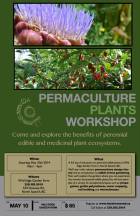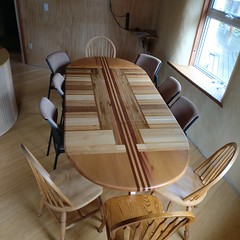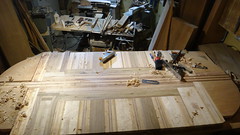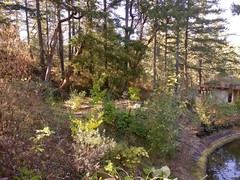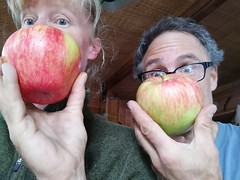Before the update… which we think is particularly pertinent at this time during the hurricanes, fires, floods, droughts, Trump and other horrible world events, we risk losing you, the reader, by saying…
HEY! Nursery is open Saturday Sept. 30 from 10am – 2pm
60 of our Grafted apple trees are now in inventory and ready to go.

Radical Homesteading! Tomatoes ready to dry. In late September I start in the oven and then move to the solar dryer.
Life itself is risky business let alone being married to Ann. For Gord, learning the art of risk assessment and adaption planning has been critical to his survival on many occasions. As with all strong marriages, outside of adaptation strategies, mitigation skills rank up there with food, shelter and beer. This week offered us the opportunity to see others share their experience, knowledge and research on all the above at the Livable Cities Forum: Advancing Low carbon Resilience. So you can just imagine the comfort we felt being immersed in a conference full of engineers, insurance professionals, chief resiliency officers, city managers, planners, and policy analysts from three levels of government discussing… how to get along in the face of risks posed by climate change.
Later in the week Gord changed gears from risk avoidance to risk taking, in the form of speaking engagements. One presentation topic was spawned from the conference from the unavoidable question that arises as folks mingle, “So, what do you do for a living?”. Gord hears that and fear shoots through his veins. What do you say? How much time do they have? How can I be concise and coherent? Gord usually defaults to the inappropriate… “I live in a mud house and I shit in a bucket.”
The risk here is that your either really quickly alienate yourself, or really quickly have another person that wants a private tour. For the Oak Bay Probus Club, Gord had to be a little more formal and tidy in answering that question… taking 50 minutes to explain that really he is somewhat unemployable because he doesn’t have a trade certification, a MA or PhD, isn’t a registered professional, and is an elected official in the smallest community in the CRD. Needless to say the group was wonderful and supportive, with lots of questions on topics of EROEI (energy return on energy invested), Solar PV and their ecological footprint in their manufacturing, economics, structural engineering of the Eco-Sense home, if Ann can be cloned, and if we sleep. Upon reflection, Gord wonder’s why they didn’t ask about cloning him?
The other presentation to the Mill Bay Garden Club… well lets just say Gord was inappropriate when someone in the audience asked “How do you protect your nuts?” From risky to risqué.
Risk really is one of those items that most of us want to avoid. After all feeling secure is so much easier. We attended the Liveable Cities Forum in Victoria, a conference where we were only two of three elected officials in attendance amongst a whole host of people that take fire, flood, climate change and resiliency really seriously. Many of these folks have to because they have had to respond to disasters in their own cities (Calgary, Montreal, Toronto). We came away feeling more energized than we ever have, and summarized our workshops and corresponding take away points in 3211 words… each. Yup … we both wrote up our reports and when we had each completed them we each were at 3211 words. Talk about a marriage made in heaven.
Links to our summaries:
Ann’s Summary of LCF2017
Gord’s Summary of LCF2017

Yummy lunch including “Escape Pods” – Fermented garlic scapes and radish pods – YUMMY. And Yes, Gord eats faster than Ann
You don’t want to read a novel you say… no problem, here is an extremely quick synopsis.
We’re screwed. Or in the words of Barbara Kingsolver in her recent interview on CBC‘s The Current, “Because climate change is really, really terrible, let’s face it. This is not going to end well.” But, there is a hell of a lot we need to do. Seriously, if you are interested in this topic and what can and IS being done, and you want to at least find some positive news on topics of the circular economy, communication strategies (which we fail on…apparently we don’t dumb it down enough), counting emissions, food, water, fire, insurance, legal issues, risk assessment, mitigation strategies, grants available to municipalities to adapt, natural assets, ecological solutions, local climate data and what we can expect here by 2050, etc, etc, etc.
Here’s a couple snippets:
The cost of inaction of preparing for a disaster is 1:10. Do it now it costs 10x less than responding later. If you react now, you have time to apply a sustainability and resiliency lens to your decision; react after then you don’t take the time to think things through and your decisions leave you at the mercy of future compounded risk. At Eco-Sense our food, water, and redundant systems will hopefully be time and monies well spent.
Fail safe. We can never catch up to climate change in both the science nor how we apply that science to our infrastructure, so when designing, expect it to fail, and design for it to fail safe.
Speak to the risk, don’t avoid sharing the bad news. As a community, especially one as small as ours, we face severe risks in the form of devastating fire, earthquake and rain events that will wash out driveways and roads. We obviously have no way to truly control for these, but we know they exist; by avoiding speaking to them we are in essence sending a false sense of security to our residents. Even if you can’t mitigate a risk, by speaking to it you are performing a public duty of informing, and thus allowing people to make their own informed choices.
After a disaster, (e.g. Slave lake), the social impacts are enormous, as people are separated from their social groups, can’t pay mortgages, health care professionals move out of town, rates of alcoholism and family violence increase. You need to plan your recovery before the catastrophe strikes because recovery starts at the same time as response.
That’s it for now.
Gord and Ann



